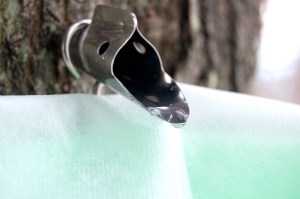“The sap rises and the angels sigh, yeah … ” -James Taylor
… And then it freezes again because it was just a freak February thaw.
There is a narrow scrim of maple trees across the back of our property, and when we looked at the house in the peak foliage of late fall last year, there were glorious red maple leaves everywhere. Our friends in Falmouth, who are accomplished homesteaders themselves, noticed the leaves and informed us that we had sugar maples! We should tap our trees! I got really excited—We could get some of those adorable maple-leaf-shaped glass jars and give homemade maple syrup for Christmas! This was before I did my research and realized that you need about thirty gallons of sap to make one gallon of maple syrup. At this point, we are hoping to get one quart of maple syrup to enjoy as a family on our pancakes on Sunday mornings over the next few months. So is it worth the effort? I don’t know yet. I’ll let you know when we start boiling the frozen sap in Part II. However, here is what I have learned so far:
To tap trees, you need a spile. This is a spile. I just like the word spile, so I try to work it into as many sentences as possible. We got a Tap my Trees Spile Kit, which includes four spiles and four hooks. So far we have used one. It works great.
You need a 7/16th-inch drill bit to drill into the trunk of a sugar maple tree. Drill at an upward angle so that when you insert the spile, the sap flows down. Make sure you clean out the hole before you insert the spile, then hammer the spile securely into the hole immediately. The sap began running the minute we took the drill away from the tree! Fix the hook on the tree side of the spile and place the sap-collecting bag or bucket onto the hook.
This is a two-gallon bucket. There are bucket covers available to prevent debris from falling into the sap, but we eventually just placed a couple layers of cheese cloth over the top of the bucket and secured it with rubber bands—a simpler and less costly solution.
At the end of the first day about a quarter of the bucket was full, and the sap was still running, so we left the bucket out overnight …
and it froze solid.







